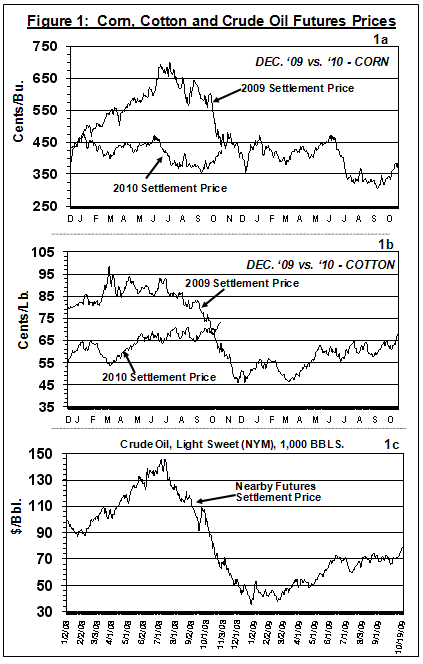Vol. 25, Issue 34, October 21, 2009 – PDF version
Jose G. Peña, Texas AgriLife Extension Economist-Management
Corn and cotton markets have been showing strength in October as the U.S. economy shows signs of recovery, investors are attracted back into the commodity market and the dollar weakens, increasing prospects for export sales. (See Figures 1a and 1b)
The Dow Jones Industrial average is up over 50% from early March lows and broke the 10,000 point barrier this past week, further supporting that investors are re-entering the market.
But, crude oil prices jumped to near $80/barrel this past week after hovering in the high $60’s-low 70’s/barrel since June. (See Figure 1c) The retail price of gasoline jumped over 20 cents/gallon during the past few days. While it appears unlikely that crude oil prices will climb to last summer’s record highs, analysts indicate that prices may increase another $5-$10/barrel before year’s end. This means higher input costs.
Corn future prices have improved during the past two weeks as prospects for colder, wet weather in the U.S. Corn Belt threatens the harvest. Also, signs of an improving economy appear to be attracting investors and a weaker U.S. dollar may trigger higher-than-expected exports. A cheap U.S. dollar makes U.S. exports, like corn and cotton, cheaper to overseas buyers and attracts investment buying in commodities as a hedge against inflation. Figure 2 provides a comparative summary of the U.S. dollar index as it compares to nearby corn and cotton futures settlement prices. (See Figure 2) As the value of the dollar goes down, corn and cotton futures prices increase, probably influenced by increased U.S. export prospects.
 December ’09 corn futures finished at $3.86/bu. on Monday (10.19.09), up 17.5¢/bu. from Friday and up about 71¢/bu. from lows of about $3.15/bu. in early Sept. ‘09. (See Figure 1a) Monday’s rally slowed near the close of the trading day as recent weather forecasts improved to more farm friendly conditions. But, the recent market improvement generally held firm on Tuesday (10.20.09) with December ’09 corn futures prices dropping just slightly to close at $3.85/bu. and December ’10 closing at about $4.24/bu. On Wednesday morning (10.21.09), when this article was prepared, December ’09 and ’10 contracts were trading at about $4.03 and $4.35/bu., respectively.
December ’09 corn futures finished at $3.86/bu. on Monday (10.19.09), up 17.5¢/bu. from Friday and up about 71¢/bu. from lows of about $3.15/bu. in early Sept. ‘09. (See Figure 1a) Monday’s rally slowed near the close of the trading day as recent weather forecasts improved to more farm friendly conditions. But, the recent market improvement generally held firm on Tuesday (10.20.09) with December ’09 corn futures prices dropping just slightly to close at $3.85/bu. and December ’10 closing at about $4.24/bu. On Wednesday morning (10.21.09), when this article was prepared, December ’09 and ’10 contracts were trading at about $4.03 and $4.35/bu., respectively.
This year’s corn crop is behind schedule. USDA’s October 19, 2009 Crop Progress report placed corn at 92% mature compared to a five year average of 97% at this same time. USDA put the U.S. corn harvest at 28% complete compared to a five year average of 46% at this same time.
Cotton futures price have been showing a steady improvement since mid-June’s lows. (See Figure 1b) While December ’09 prices were off on Monday (10.16.09) to close at about 66.4 cents, prices are just two cents below last Friday’s (10.16.09) recent highs and up significantly from mid-June’s lows of about 55.5 cents/lb. The market was back up on Tuesday (10/20/09). December ’09 and ’10 contracts closed at about 67.23¢/bu., and 73.5¢/lb., respectively.
Corn
USDA/s October 9, 2009 corn production estimate for 2009/10 at 13.018 billion bushels, is up 63 million bushels from last month’s estimate and just 20 million bushels below 2007’s record crop of 13.038 billion bushels. While USDA lowered the estimate of acres for harvest by 713,000 acres from last month’s estimate, USDA increased the national average yield to a record 164.2 bu./ac, up 2.3 bu./ac from last month’s estimate.
U.S. corn supplies are projected at a record 14.702 billion bushels, up 340 million from the previous record in 2007/08. Total use at 13.03 billion bushels was increased by five million bushels from last month’s estimate. Total use will exceed production by 12 million bushels. Ending stocks are up 37 million bushels from last month’s estimate but down slightly from last year. The 2009/10 marketing-year average farm price remained unchanged from last month at $3.05 to $3.65 per bushel, compared with $4.06 per bushel for the 2008/09 season.
Cotton
USDA’s October 9, 2009 supply/demand report increased beginning stocks slightly but reduced the size of the U.S. cotton crop by 440,000 bales to 13.0 million bales. Texas accounted for most of the decline. Production in the Mississippi Delta states was reduced 85,000 bales. Domestic mill use was lowered, reflecting the continued sluggish pace of U.S. textile exports. Cotton exports remained unchanged at 10.5 million bales. Ending stocks was reduced 200,000 bales to 5.4 million.
With over 80 percent of the 13 million bale production estimate slated for export, the U.S. cotton industry continues to remain export dependent, subject to many foreign rules and regulations.
Forecasts for the 2009/10 world crop were virtually unchanged, leaving a carryover of 56.1 million bales. That is six months of use when supplies for 4.5 months are normally sufficient. But, world carryover stocks have decreased by close to seven million bales in the last two years from 63.1 million to 56.1 million. Most of the decrease in ending stocks has been in the U.S. where stocks have dropped from 10.0 million to 5.4 million bales.
USDA reduced the forecast of the high end of the average price received by producers for the marketing-year by two cents/lb. to a range of 49 to 57 cents.
Appreciation is expressed to Dr. Jackie Smith, Ext. Economist-Management for his contribution to and review of this article.

